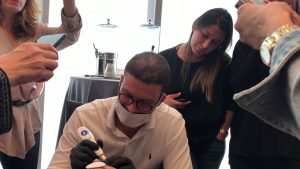The beauty and wellness industry continues to expand, with non-surgical hair replacement becoming an increasingly popular field. This specialized area offers a unique blend of artistry, precision, and empathy for individuals seeking solutions to hair loss. For those looking to start a career in this growing sector, non-surgical hair replacement training provides comprehensive skills and knowledge, setting up future hair technicians for success. In this article, we’ll explore what non-surgical hair replacement is, the benefits of entering this field, the essential elements of quality training, and potential career pathways.
What is Non-Surgical Hair Replacement?
Non-surgical hair replacement is a process that involves creating and attaching custom hair systems to a client’s scalp. Unlike surgical methods, such as hair transplants, non-surgical techniques provide immediate, natural-looking results without invasive procedures or long recovery times. This approach appeals to individuals of all ages dealing with hair loss due to genetics, medical conditions, or lifestyle factors, as it offers a non-permanent, customizable solution tailored to each client’s unique needs.
Why Pursue a Career in Non-Surgical Hair Replacement?
With over half of men and a significant percentage of women experiencing some form of hair loss in their lives, there is a high demand for effective, accessible solutions. Non-surgical hair replacement provides an option that can be adjusted over time, giving clients the flexibility to try new styles and colors as they wish. Here are some key reasons to consider this rewarding career path:
- High Demand for Services: With a growing market of men and women seeking hair replacement, skilled professionals are in demand. Trained specialists can expect a steady stream of clients seeking personalized, effective solutions.
- Flexibility and Creativity: Hair replacement involves a blend of artistry and technique. Each client has unique needs and preferences, allowing technicians to express creativity through various styles, colors, and system designs.
- Positive Impact on Client’s Lives: Hair loss can be an emotionally challenging experience, affecting a person’s self-esteem and confidence. By restoring clients’ hair, you help them regain a positive self-image, making a tangible difference in their lives.
- Lucrative Career with Growth Opportunities: As a non-surgical hair replacement technician, you’ll have opportunities to work in salons, wellness centers, or start your own business. This skill set can also be expanded to include scalp micropigmentation (SMP), wig making, or other hair restoration techniques.
Key Components of Non-Surgical Hair Replacement Training
A comprehensive training program is essential to become proficient in non-surgical hair replacement. Training programs can vary in length and depth, with some offering short courses and others providing in-depth certification programs. Below are the essential components covered in quality training courses:
1. Understanding Hair Loss Causes and Solutions
A strong foundation in the various causes of hair loss is critical for recommending the most suitable solutions. Training will cover medical, genetic, and lifestyle factors that contribute to hair loss, giving you the insight needed to empathize with and advise clients. You’ll also learn about different types of hair systems, materials used, and when each solution may be appropriate.
2. Custom Hair System Design and Selection
Creating a custom hair replacement system involves understanding clients’ preferenctraes, face shapes, and lifestyle needs. Training programs will typically cover the basics of measuring, template making, and customizing hair systems to fit clients comfortably and look natural. Trainees will learn to select the best base materials, hair types, and textures to ensure a seamless blend with the client’s existing hair.
3. Attachment Techniques
One of the most important aspects of hair replacement is the attachment process. Proper attachment methods ensure that hair systems stay secure, natural-looking, and comfortable for clients. Training courses typically cover different attachment techniques, including bonding adhesives, tapes, and clips. Mastery in this area minimizes potential issues for clients and enhances the durability and comfort of the hair systems.
4. Cutting and Styling Techniques
Cutting and styling are essential for creating a realistic, aesthetically pleasing hair replacement system. Trainees learn to blend the hair system with existing hair, apply layers, and perform touch-ups for a natural look. Hands-on practice helps trainees become skilled in cutting and styling, so clients walk away with a cohesive look that suits them.
5. Maintenance and Aftercare
Regular maintenance is key to prolonging the life of hair systems and ensuring clients enjoy the best possible results. Trainees learn about aftercare products, techniques, and maintenance schedules. This includes reattachment methods, system cleaning, and troubleshooting issues such as tangling or shedding. By educating clients on aftercare, technicians also foster long-term relationships and potentially recurring business.
Choosing the Right Training Program
Selecting a reputable hair replacement training class program is crucial for success in this field. Look for programs that offer hands-on training, as practicing with real hair systems builds confidence and skill. Some training centers provide advanced certification or even job placement assistance, which can be invaluable for launching your career. It’s also beneficial to seek instructors with industry experience who can offer practical insights and guidance.
Career Pathways and Opportunities
After completing training, graduates can pursue careers in various settings. Many work in specialized salons or wellness centers, while others start mobile services that bring hair replacement directly to clients’ homes. Some professionals go on to open their own hair replacement studios, offer scalp micropigmentation, or even teach others entering the field.
Given the rise of e-commerce and social media, technicians can also market their skills online, reaching a wider client base. With the right blend of technical expertise and customer service, non-surgical hair replacement professionals can build a loyal clientele and carve out a profitable niche in the beauty and wellness industry.
Conclusion
Non-surgical hair replacement is a field that combines artistry, technical skill, and a desire to make a positive impact on clients’ lives. With comprehensive training, aspiring professionals can develop the expertise needed to create natural, confidence-boosting transformations for clients. As demand for non-surgical hair solutions continues to grow, so do the opportunities for skilled hair replacement specialists, making this a highly rewarding career choice.
